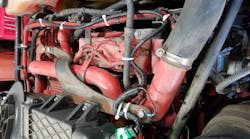The Cummins Filtration FleetGuard FIT, which stands for filtration intelligence technology, is a vehicle filtration monitoring system designed to provide real-time information and visibility on the status of filters on a commercial vehicle.
“The kit provides full visibility to the service life of fuel, lube, [and] air filters, as well as the indicative health of the lube oil,” explains Erica Clark-Heinrich, chief engineer for Cummins Filtration. “We use on-engine sensors and advanced algorithms to understand the condition of the filters and the oil, and then provide that information to the end user.”
The installation
The Fleetguard FIT system works by connecting to the engine’s ECM, communicating through J1939 parameters on the vehicle’s CAN bus network.
The system uses sensors to collect data on the status of the vehicle’s filters. Sensors are attached to the filter housing. Data collected from the sensors is then collected and provided to fleets. “We currently pair with the vehicle telematics system but [also] have ongoing development projects for on-vehicle connections as well,” says Clark-Heinrich.
“The Fleetguard FIT parameters are automatically rolled into those telematics offerings. What that means is the telematics [provider] is now able to view our parameters,” explains Clark-Heinrich. When it comes to partnering with a telematics system, Fleetguard currently works with a number of telematics providers, including Omnitracs, PeopleNet, and Geotab.
The end goal is to have full integration into these telematics systems. Currently, fleets can include an application programming interface (API) on the backend to transfer and view the filtration information from Fleetguard FIT on any number of telematics systems.
Fleets can otherwise view this information on a standalone interface or mobile application for a smartphone or tablet as well.
The Fleetguard FIT system can provide filter status and remaining life in mileage, operation time, or both.
The system is currently an aftermarket install and takes about two hours per vehicle.
The standard filtration monitoring system kit comes with sensors and hardware for monitoring the stage two fuel filter, the engine oil filter, and the engine air filter. On the engine air filter, a green, yellow, or red visual light indicates the overall filter status.
An add-on differential pressure kit can be used to monitor a stage one fuel filter – typically seen on severe duty or mining applications.
Clark-Heinrich says the algorithms developed for the Fleetguard FIT program are ideally designed for use with Fleetguard filter media’s loading and plugging patterns. “We highly recommend the use of our filters to get the most accurate prognostic information,” she adds.
Diesel particulate filter (DPF) monitoring is currently in development, but no specific launch date has been announced.
Improvements with maintenance
“Our intent is to provide real-time information that can help end users or fleets proactively monitor, plan, and optimize their maintenance spend,” says Clark-Heinrich.
Clark-Heinrich adds that real-time monitoring can help tailor information to the needs of each fleet, improving the total cost of ownership to extend the life of vehicle filters. Plus, it can help improve maintenance practices. She cited specific examples of where fleets have seen improved procedures with implementing the Fleetguard FIT system.
“We caught a missing air cleaner cover on a particular truck,” Clark-Heinrich says. “We noticed a heavy duty application where they changed the lube oil but forgot to change the filter. We saw an example of a loose connection on an air cleaner system that allowed for dust ingest and eventually turbo damage. We’ve noticed environmental effects causing non-uniform loading.”
Clark-Heinrich offered another example, of a mulch and landscaping fleet which had been proactively replacing the engine air filter on a weekly basis.
Using a condition-based maintenance approach implemented through the Fleetguard FIT system, Clark-Heinrich says the fleet ended up replacing the air filters less frequently, as needed, instead. “They reduced their changing of air cleaners from every week to about every three to six months, depending on usage and the time of year,” she said.
Improvements to other vehicle systems
Cummins Filtration is in a unique position, because they are a segment of the Cummins organization, which also focuses on other areas of the vehicle’s powertrain.
“We have access to thousands of engine parameters,” says Clark-Heinrich. “Cummins as a whole can use this data to improve reliability and help introduce smarter, better, new products.”
“We now in turn are using data science to better understand the interactions between filtration systems and the downstream components,” she adds.
For example, monitoring filter health – the overuse of engine air filters - in conjunction with these engine parameters can provide a better understanding of fuel economy. By having a holistic view of the system, data scientists can analyze intake manifold pressure, and how a high restriction on the air intake can impact the performance and life of components such as engine cylinders.
Down the line, Cummins Filtration is planning other initiatives such as fuel condition monitoring and hydraulic fluid health.
“There [are] regions of the world that really have a hard time with getting quality fuel; and bad quality fuel is a huge variable that can effect lots of fuel system components,” says Clark-Heinrich.
Hydraulic fluid health in particular would be beneficial to the refuse, construction, and mining markets.




